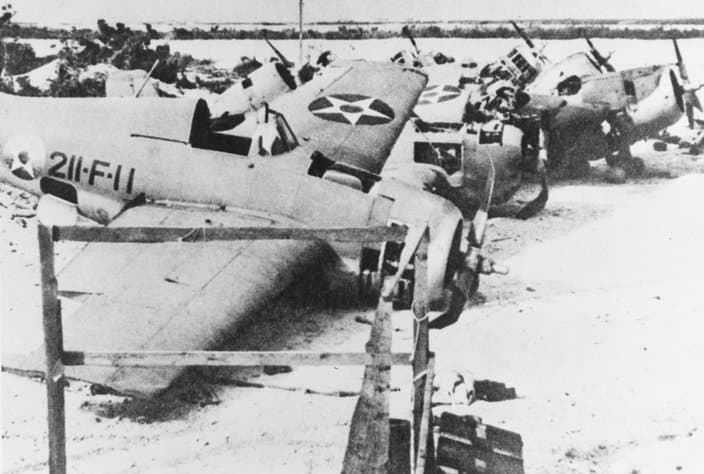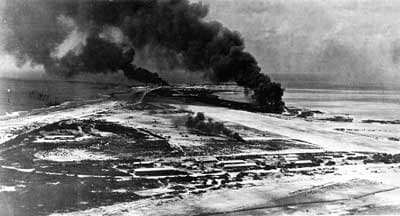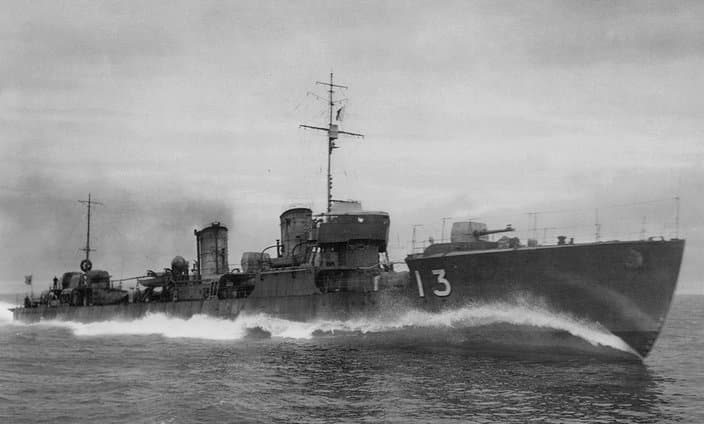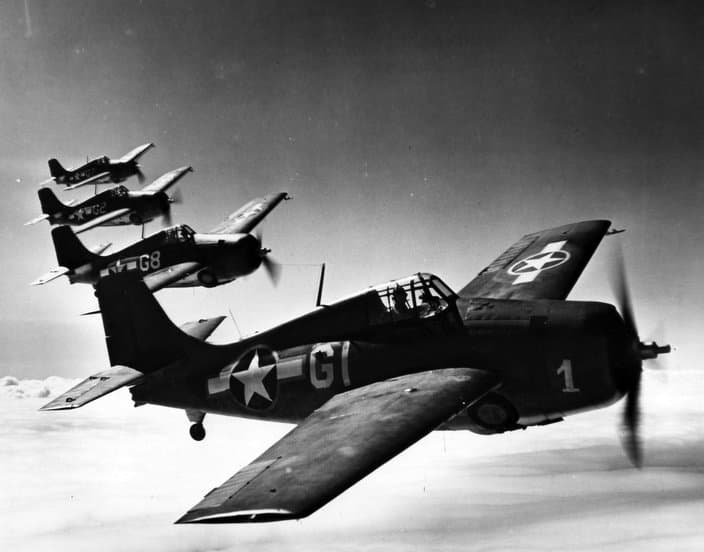By Ben Ho Wan Beng and Gary Lehmann
 Expeditionary Advance Base Operations (EABO) is the new Navy-Marine Corps concept for using land units forward-deployed ashore to help win a naval war. EABO is intended to turn the tables on our adversaries’ Anti-Access/Area Denial (A2/AD) strategies, using island outposts to help US land, sea, and air forces survive and fight in the face of enemy sensors and long-range precision missiles. According to the 2017 concept for Littoral Operations in a Contested Environment (LOCE), EABO proposes deploying relatively modest forces — companies, platoons, even single squads — in austere temporary locations, hidden from enemy sensors and able to rapidly relocate when found. This would confound enemy planning by forcing them to split their resources over a wider and more dispersed set of threats.
Expeditionary Advance Base Operations (EABO) is the new Navy-Marine Corps concept for using land units forward-deployed ashore to help win a naval war. EABO is intended to turn the tables on our adversaries’ Anti-Access/Area Denial (A2/AD) strategies, using island outposts to help US land, sea, and air forces survive and fight in the face of enemy sensors and long-range precision missiles. According to the 2017 concept for Littoral Operations in a Contested Environment (LOCE), EABO proposes deploying relatively modest forces — companies, platoons, even single squads — in austere temporary locations, hidden from enemy sensors and able to rapidly relocate when found. This would confound enemy planning by forcing them to split their resources over a wider and more dispersed set of threats.
An Expeditionary Advanced Base (EAB) is not a fixed position. It is more like a package of capabilities tailored to a particular mission, such as intelligence, surveillance, and reconnaissance (ISR); future anti-ship cruise missiles; and forward arming and refueling points (FARPs). EABs could also control, or at least contest, sea lines of communications and naval chokepoints like narrow straits, denying their use to the enemy.
Wake Island burns after a Japanese attack
 So how can the enemy counter such island bases?. While EABO is not explicitly directed at China, Beijing’s strategic ambitions and military advances are undoubtedly key drivers. If we were strategists in the People’s Liberation Army (PLA) responsible for planning island-chain operations in the western Pacific, it would stand us in good stead to study a lesser-known battle of World War Two: the 1941 fight for Wake Island. That battle pitted a small, defended island against more powerful enemy sea forces — a contest that may well be replicated during a notional Sino-American war.
So how can the enemy counter such island bases?. While EABO is not explicitly directed at China, Beijing’s strategic ambitions and military advances are undoubtedly key drivers. If we were strategists in the People’s Liberation Army (PLA) responsible for planning island-chain operations in the western Pacific, it would stand us in good stead to study a lesser-known battle of World War Two: the 1941 fight for Wake Island. That battle pitted a small, defended island against more powerful enemy sea forces — a contest that may well be replicated during a notional Sino-American war.
The Battle of Wake Island began on 11 December 1941, four days after the Pearl Harbor attack, with a Japanese expeditionary force trying to take over the mid-Pacific atoll. The meager US Marine forces on Wake initially repelled the invaders, with shore-based naval guns sinking two destroyers and damaging several other ships. The Imperial Japanese Navy (IJN) made a second attempt to subdue the atoll with much more powerful forces, and Wake’s besieged defenders had to surrender on 23 December 1941.

Imperial Japanese Navy destroyer Hayate, destroyed by Marine Corps shore batteries off Wake Island in 1941.
Lesson One: Outrange the adversary
The first, most obvious, lesson from the Battle of Wake is to strike at defended islands while staying out of range of their weaponry — which, being landbound, can’t pursue your ships. While outranging the enemy is applicable to all aspects of warfare, it is especially significant in naval operations, where getting in the first effective shot is, as the doyen of naval combat Wayne Hughes puts it, “the great naval maxim of tactics.”
Overconfident in his forces’ superiority, Rear Admiral Sadamichi Kajioka, the invasion force commander, was lured into the firing envelope of Wake’s coastal-defense batteries, despite having the range advantage: The largest guns on Wake were five-inchers, while the light cruisers in the Imperial Japanese Navy (IJN) force had six-inch batteries. While these cruisers began firing at the island beyond the range of its defenses, they exacted scant damage. From the lack of activity on Wake, Kajioka thought he had surprised the Americans and approached within range of the island’s five-inchers.
A derelict coastal defense gun still stands guard over Wake Island.
 In the engagement that followed, the Americans – notwithstanding their obsolete fire-control mechanisms – sunk the destroyer Hayate while damaging several other ships, including the light cruiser Yubari (Kajioka’s flagship), and three other destroyers. The IJN withdrew. Esteemed naval historian Samuel Morison wrote: “Never again, in this Pacific war, did coast defense guns beat off an amphibious landing.”
In the engagement that followed, the Americans – notwithstanding their obsolete fire-control mechanisms – sunk the destroyer Hayate while damaging several other ships, including the light cruiser Yubari (Kajioka’s flagship), and three other destroyers. The IJN withdrew. Esteemed naval historian Samuel Morison wrote: “Never again, in this Pacific war, did coast defense guns beat off an amphibious landing.”
In a war where the PLA may target EABs, the Chinese would do well to strike these positions from beyond the reach of their weaponry. In this regard, Beijing is well served by its “projectile-centric strategy,” emphasizing the PLA’s long-range missiles.
Fortunately for Beijing, the main anti-surface capabilities currently available to US forces are relatively short-ranged. The High Mobility Artillery Rocket System (HIMARS) that the Marine Corps is reportedly mulling for the ship-killing component of EABO can hit targets some 70km to 300km away. In stark contrast, one of the most numerous short-range ballistic missiles in Chinese hands, the DF-15, can strike targets over 600km away: DF-15s in coastal China could strike many parts of the Ryukyus where EABs are likely to be. [Part of the problem is that the US still abides by its 1987 Intermediate Nuclear Forces (INF) treaty with the then-Soviet Union, which bans ground-based missiles with ranges between 500 and 5,500 km; Russia has allegedly broken the treaty and China never signed it — the editors]
A barrage of Chinese cruise and ballistic missiles here would outrange the Americans, obviating the need for the PLA to commit other resources against EABO forces. To be sure, some have contended that new technologies like the Hyper Velocity Projectile will nullify the missile threat. These capabilities, however, are still very much on the drawing board. Moreover, missile defense has had a less-than-stellar operational history – witness the travails of the Patriot system used by the U.S. and many of its allies, including Japan.

F4F Wildcats in formation. The air forces defending Wake comprised just four of these fighters.
Lesson Two: Weaken his air support
The next lesson from the Battle of Wake would be to weaken the airpower supporting the EABs. Maritime expert Milan Vego has argued that “the most critical prerequisite for success in littorals is air superiority.” But — again, arguably out of hubris — the Japanese did not establish air superiority over Wake in the initial stages of the battle. Indeed, the first landing attempt did not even have air cover. As the Japanese fleet retreated, it was attacked by the four remaining Wildcat fighters on the island (the rest having been destroyed pre-invasion by the Japanes) which sank another destroyer, Kisaragi, and hit several other vessels.
To be certain, the Americans were lucky here: Kisaragi died when a mere 100-pound bomb set off its depth charges. But if the Japanese had deployed proper air cover, the Wildcats couldn’t have attacked at all. Indeed, it was only after the entire Wildcat complement on Wake had been destroyed that the Japanese were able to subdue the island.
What PLA strategists should take away from this episode is that taking out an EAB becomes much more risky and complicated if it has even limited air support. Chinese planning considerations should include the following assumptions:
EABs would not permanently host tactical aircraft such as the F-35 (except perhaps future swarming drones);
EABs will have ground-based anti-air and anti-ship weapons;
EABs will establish Forward Arming and Refueling Points (FARPs) to support friendly aircraft, which may or not be present when the base is attacked; and
EABs may receive air support from US carriers and more distant land bases in extremis.
These factors mean the PLA must win the “reconnaissance/counter-reconnaissance competition” with EAB forces, using special operations forces, long-range manned and unmanned ISR platforms, standoff precision munitions, and offensive cyber operations to disrupt and prevent effective EAB command and control. If the Chinese forces can locate the US bases without being located in return, the stage would be set for the PLA to launch quick and decisive surprise attacks.
A wrecked Japanese patrol boat run aground on Wake Island.
Lesson Three: Defense is inherently stronger than offense
 As the Prussian sage Carl von Clausewitz asserted, it is “easier to hold ground than take it. It follows that defense is easier than attack.” The Japanese ignored this truism at Wake. Even though the Japanese had comparatively more firepower in their initial assault, they failed to concentrate the strength to overpower Wake’s defenses. Even if the Japanese had managed to defeat the Wildcats and coastal guns and land on Wake on their first try, it is highly doubtful that their 450 Special Naval Landing Force troops would be able to dislodge the 390-odd U.S. Marines on the atoll. Traditional military doctrine calls for the attacker to have a three-to-one superiority over the defender.
As the Prussian sage Carl von Clausewitz asserted, it is “easier to hold ground than take it. It follows that defense is easier than attack.” The Japanese ignored this truism at Wake. Even though the Japanese had comparatively more firepower in their initial assault, they failed to concentrate the strength to overpower Wake’s defenses. Even if the Japanese had managed to defeat the Wildcats and coastal guns and land on Wake on their first try, it is highly doubtful that their 450 Special Naval Landing Force troops would be able to dislodge the 390-odd U.S. Marines on the atoll. Traditional military doctrine calls for the attacker to have a three-to-one superiority over the defender.
Having apparently learned their lesson from the first failed landing, the the second Japanese attempt was much stronger, including several heavy cruisers that provided long-range firepower. Two veterans of the Pearl Harbor strike force, the aircraft carriers Hiryu and Soryu, were also deployed, but they were tasked to only provide distant cover a few hundred kilometers away from the invasion fleet, dramatically limiting their effectiveness. Had the Americans carried out their original plan to send their own carriers to relieve Wake, the Japanese flattops might not have been able to protect wreaking havoc on the invasion force. Imperial Japan’s proclivity to divide its forces would continue to rear its ugly head later in the war, often with disastrous consequences.
So should the Chinese concentrate overwhelming force on an EAB to defeat it? Not necessarily. PLA thinkers should consider whether a small and relatively lightly defended enemy base, such as the typical EAB, really justifies expenditure of large amounts of ordnance on it? As naval analyst Bryan Clark argued “the idea is not to make it invincible, (but) to make the EAB a hard enough kill for a pretty low-value target.” Indeed, as large as the missile inventory of the PLA Rocket Force may be, it could be depleted rapidly during a war, especially if it had to target large numbers of individually weak but collectively dangerous EABs.
One solution is for the Chinese to target only the most critical EABs. Another way would be to utilize special operations forces, which can do tremendous damage to lightly defended targets and, unlike missiles, can be reused.

Conclusion
In the final analysis, arrogance underpinned Tokyo’s failure in the initial stages of the Wake Island campaign. It seemed that “Victory Disease” had already set in within the early weeks of the Pacific War, and this malady would only worsen as the months went on, culminating at Midway. Therein lies another obvious lesson which militaries have surprisingly often failed to heed: never underestimate your enemy.
While the United States Navy is currently going through troubled times – witness the tribulations of the Ford-class supercarrier and Littoral Combat Ship, as well as the recent ship collisions – it is still the first-class navy in the world, and China would discount the U.S. at its own peril. Beijing should play to its strengths with its asymmetric strategy to counter the Americans, rather than compete head-to-head.
The United States, too, should learn from these lessons to make Expeditionary Advanced Bases more survivable. EABs, being relatively small and austere, are unlikely to be able to outfight the enemy; the key to their viability is to reduce the odds of being detected, targeted, and outranged. EABs should focus on minimizing detection to gain the upper hand in the “reconnaissance/counter-reconnaissance” competition. To this end, passive protection measures, like decoys, deception, concealment, camouflage, and signature-management — i.e. reducing radio and radar emissions — should be pursued more vigorously over kinetic ones like missile defense. The goal is to create Expeditionary Advanced Bases that can help deter, or if need be, help win the next Pacific war.
Ben Ho Wan Beng
Ben Ho Wan Beng is a senior analyst with the military studies program at Singapore’s S. Rajaratnam School of International Studies. He writes primarily on naval affairs, and his work in this area has been published in the likes of theNaval War College Review, Journal of Military and Strategic Studies, andRUSI Defence Systems.
Gary Lehmann
Lieutenant Colonel (Retired) Gary Lehmann served more than 20 years as an active-duty infantry officer in the United States Marine Corps, and has more than 12 years of experience as a contractor, primarily in support of the Marines and Joint Staff. He has been published in the Marine Corps Gazette, Joint Force Quarterly, Proceedings, and DefenseWatch magazine.
No comments:
Post a Comment